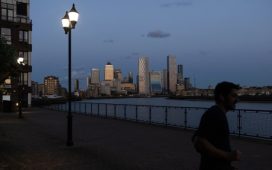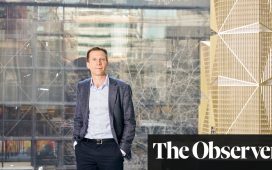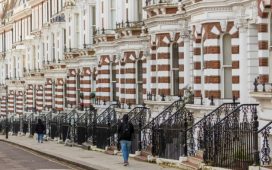Two years ago the developer Michael Stern toasted his super-tall tower at 9 DeKalb Street as “a symbol of Brooklyn’s unceasing drive and ambition.” Now the city’s first — and only — super-tall outside of Manhattan is shrouded in gloom and uncertainty.
The Brooklyn Tower, as it is known, is scheduled to go to auction on June 10 after its lender, Silverstein Capital Partners, initiated foreclosure procedures against Stern’s company, JDS Development Group, for defaulting on a $235mn mezzanine loan.
Depending on how things play out, Silverstein, the developer of the rebuilt World Trade Center, could take control of the unfinished building. Alternatively, its gambit could open a legal fight with the enigmatic Stern over a polarising tower that has remade Brooklyn’s skyline but may end up an albatross for its investors.
The obvious culprit for its financial struggles is the sharp rise in interest rates that began in early 2022, leaving all manner of real estate projects saddled with debts they cannot refinance. The worst affected has been the office sector, but investors in other real estate categories have also found that credit is either too expensive — or unavailable.
“This won’t be the last of these stories,” said Adelaide Polsinelli, a longtime New York City broker and vice-chair at Compass. “Borrowers are defaulting everywhere due to the spike in interest rates and slower sales. No asset class is safe.”
Brooklyn Tower may be more vulnerable because it is behind schedule, over budget and arguably over leveraged. The building was supposed to have been completed in 2022. Some residents of the unfinished tower complain that promised amenities have yet to be delivered.
Stern burst on to the city’s development scene 15 years ago and has gained a reputation for dazzling projects such as 111 West 57th, a willowy super-tall that rises out of the historic Steinway building below. He recently teamed with Mercedes-Benz to build a branded tower in Miami.
But Stern has been prone to delays that sap investors’ returns and necessitate additional financing. He has also fallen out with partners.
Earlier this year he was sued by a leasing company, which alleged he failed to pay about $1.3mn in charges for a private jet. JDS has described the lawsuit as meritless.
Silverstein opted to foreclose on Brooklyn Tower in order to oust Stern from the project, according to people briefed on its plans.
In a statement, Silverstein confirmed that junior and senior mezzanine debt and mortgage loans were all in maturity default, and that property broker JLL was organising a sale. It declined to comment further. Stern did not respond to requests for comment. In 2020 he told the Financial Times that litigation was inevitable in the real estate business, saying: “If you’re not being sued by people, you’re not doing enough work.”
Even before its default, Brooklyn Tower was a talking point. Its skin of fluted black stainless steel exudes a certain menace that has prompted locals to call it “Sauron” — a reference to the dark tower in the Lord of The Rings trilogy. Some would rather see it on Manhattan’s Billionaire’s Row, on West 57th Street, beside other super-talls — not in Brooklyn. But many architecture critics have applauded it.
The 1,066-foot tower stretches 93 storeys high and sports a basketball court and dog run on its 66th floor, as well as a rooftop pool and “sky lounge”. Its 150 condominiums were originally listed at prices ranging from $875,000 for a studio to $8mn for a four-bedroom flat. The tower also has 400 rental units on lower floors. At its base is the former Dime Savings Bank, a domed, neoclassical landmark that JDS has restored and converted to retail.
Stern assembled the parcel with fellow developer Joseph Chetrit, paying $90mn for the Dime building in 2015. It came with 300,000 square feet of air rights that ultimately enabled him to build a taller tower. The borough’s approval the following year appeared to signal a new era for downtown Brooklyn, with the arrival of Manhattan-style condominiums — and prices.
After years of searching, JDS secured $664mn in construction financing from Silverstein and Otera Capital, the real estate arm of Quebec’s pension fund, in April 2019. Silverstein’s share — the $235mn mezzanine loan — inaugurated a new lending division it launched in 2018. It is a line of business several big developers have entered since banks reined in their real estate lending after the 2008 financial crisis.
The tower topped out in 2021, and some residents have moved in, but construction is still ongoing. Costs have been pushed up by inflation and shortages of raw materials that have afflicted an array of manufacturers and industries. Silverstein declined to say when the tower would be completed — or how many units remained to be sold.
The torrid Brooklyn housing market was cooled last year by high mortgage rates. In the fourth quarter the borough’s median home price fell 3 per cent from a year earlier to $725,000, according to the Corcoran Group. For new developments, the number of sales dropped by nearly half. Corcoran expressed “cautious optimism” for 2024 as rates have now begun to fall and the economy has remained resilient.
Until its future is resolved, though, the Brooklyn Tower will face added challenges trying to woo luxury buyers. “People are living in a building that’s in foreclosure and they’re still selling it,” one broker marvelled. “Can you believe that?”











